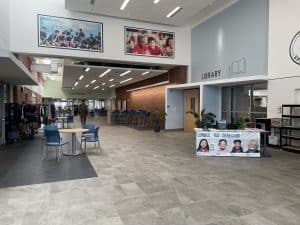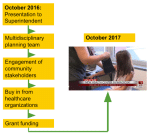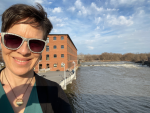The Learning Community of Winooski, Vermont
CompetencyWorks Blog
Natural light fills the main atrium of the Winooski Schools K-12 complex. Beyond the expected main office, the first steps entering the building reveal the community connections and services offered by the school and its partners. There is a health and dental clinic, an entrance to the cultural liaisons’ office, a necessities store with clothing displayed and food staples on offer without charge, the school library, and open space with high tables and chairs in the space before the cafeteria. When we arrive for our day before the start of school, the cafe area is quiet, but an hour later it bustles with students grabbing breakfast items. There is also a table with a “know your rights” banner and information.

Winooski, Vermont is a small city – both in terms of its population and just over one-square mile size. The Winooski School District serves approximately 800 students in an elementary school and middle-high school both within the same complex. Approximately 57% of students identify as BIPOC (Black, Indigenous, and People of Color), 33% receive multilingual learner services, and 25% qualify for special education services. From students to the superintendent and school board members, people point to the rich diversity of the community – the only community in the state where residents of color outnumber white residents, in large part due to it becoming a key refugee resettlement community over the past 40 years.
The journey of Winooski as a community-based, student-centered, proficiency-based learning community began over a decade ago and continues to be a work in progress. As we explore that story and how it illustrates the design principles of the community schools model and competency-based education, we’ll dig into key milestones and unpack the dynamic elements of the structures, pedagogy, and culture that exist today and continue to evolve.
A Community-Based Model for Education in Winooski
There is a vibrant relationship between the community and school in Winooski. The stance of starting from community needs has led to numerous partnerships with community organizations, local businesses, and institutes of higher education. Understanding and meeting the needs of families and the community is part of the mindset and culture of school leaders and supports students in being ready to learn.
The community participated in shaping the learning goals for its students. Winooski was an early leader in engaging its community in defining a shared vision of a graduate and accompanying graduate expectations and proficiencies. They initiated the work a bit before Vermont Act 77 on Flexible Pathways – the 2013 legislation that paved the way for proficiency-based graduation requirements – passed, making Winooski an early and influential proof point informing the policy change.
Winooski’s early work led to a student-centered systems transformation grant from the Nellie Mae Education Foundation, which required working with a lead community partner in the transformation process. The current school board chair, Robert Millar, who also served in the early phase of the work (2010-12), reflected on the change over the past decade plus saying, “Winooski was once considered one of the poorest five cities in the United States, but despite that has cultivated a strong sense of community centered around its schools. Winooski supports its schools and is in turn supported by the schools.”

As is common in community schools, a number of “wrap around services” utilize the physical school building and the communication channels to meet a broader set of needs beyond academic learning. The Winooski School District Health Suite, offering both health and dental care, is an example of this. The Health Suite’s mission is to “increase access to quality physical, dental and mental healthcare services for Winooski students, reduce healthcare disparities, and keep students safe, healthy, and well within their families and community.” Started as an idea presented to the superintendent in the fall of 2016 and launched the following year, the model and services have continued to expand and evolve over the years. Although most students have a primary care provider or a dentist, the Health Suite reduces the barriers families face in accessing care, such as taking time off of work or a lack of transportation.
A number of other services provide welcoming and culturally affirming support for families. The Necessities Store partners with the Vermont Food Bank to offer a selection of food and winter clothing to students and their families at no cost, as well as to community members on designated days. The Multilingual Learners Department provides “interpreting and translation services for families, tutorial support for students and professional development on their diverse cultures for staff.”
Connection within the Learning Spaces
Community features in the pedagogical model at Winooski as well. At the Winooski Middle-High School (WMHS), they employ a primary person model, which ensures that every student has a relationship with at least one adult in the school who knows them well. The design of the advisory program anchors this commitment. At the middle levels (grades 6-8) and at the high school levels (grades 9-12), each student is part of a consistent advisory group over the course of their time in those grades. Teacher and high school advisory coordinator Lindsey Cox explains, “it’s really important that students understand what it means to be a part of a really strong, supportive community.”
Community-building happens through an intentional variety of advisory practices, for example, Monday circle conversations designed around the CASEL social emotional learning competencies. Cox describes the intention and impact, noting, “what [circles] really do is provide our students with an opportunity to engage in learning skills like decision making, social interaction, or self-awareness that are going to help them in school, but also out in the community.” Nadia, a ninth grade student, echoes the commitment to getting to know students in her own words: “Everyone’s chill with each other, and everyone gets along. And it feels like people actually care about you…teachers have the best intentions, and they actually want to help you to have success.”

Though a redesigned space is not necessary to do learner-centered transformation, when Winooski started a major capital update to the education complex, it used the opportunity to enhance and solidify the work they began years earlier. Co-principal Jean Berthiaume reflected, “we really designed intentionally to have spaces…in which students and teachers and community members can engage with one another. And that has allowed and made a huge difference in really having a school building that matches our vision of teaching and learning with a community in mind.”
Finished in the 2022-2023 school year, the building design was informed by a community process, which generated guidelines for the architects, including designing from values such as equity and community, and also considering the value of natural light. Spaces include “the hub” which provides gathering space by the stairs between the first and second floors of the high school, a quiet inner courtyard visible through glass walls, and spaces for 1:1 support within the middle school pods. The curriculum director, Michael Eppolito, also names the advantage he has as an instructional leader in that he can see a pre-K, middle, and high school classroom in the matter of minutes.
Proficiency-Based, Flexible Learning
The proficiency-based learning system and flexible pathways at WMHS have been evolving over multiple years. The graduation requirements include “graduation proficiencies” and “graduate expectations.” Students demonstrate proficiency in a dozen graduate proficiencies aligned with core disciplinary skills through courses and other learning opportunities. They also complete Capstone projects in three of the six “graduation expectations” which align to the portrait of a graduate. One capstone must be in Communication and then students can choose two of the remaining five areas: Creativity, Critical Thinking, Culture & Community, Persistence, and Wellbeing.
In the learning spaces we observed, from regular classes to capstone classes to advisory, students were engaged and interactive. The relationships and community within the school set the tone and there are many examples of relevant, community-based learning, which we’ll dig into in a future post. Co-principal Kate Grodin articulated how self-directed learning, project-based learning, community, and relationships work together at WMHS. She explained:
“In my heart, the mission of our work here is to be a vibrant community school. It is this idea of creating a place where students are self-directed learners and develop the agency and self-actualization skills to be able to think about who they are, who they want to become, and what they want to do next. A place where they can try a lot of different things, can fail often in order to succeed, and find adult supports and peer supports along the way that give them the confidence and see things in them that they may not even see in themselves originally.”
Leo, a senior, shared an example of one of his year-end capstone projects in which he worked with the city to redo the tree ordinance for how the city manages the trees on city grounds. He reflects that the community-connected capstone projects highlight “an area where the school has given me a good opportunity to find something that I’m interested in and then make a change for something that I would like to work towards, something that I actually am academically interested in and personally interested in.”
Celebrating in Community
On the evening of our visit day we joined a Community Iftar event. The now annual event started in 2021 during the COVID disruption, with food that people picked up and ate while on a community Zoom session. Earlier we noticed the decorations created with student volunteers in the corner of one of the lead organizing teacher’s room. The energy with the cafeteria transformed by the decorations and an estimated 250+ people underscored that the event has grown.

Seeing many of the students, teachers, and administrators we spoke to during the day gathered in community brought home the depth and breadth of the community connection in Winooski. A range of people offered reflections and remarks about the community and the meaning of Ramadan, including the Winooski mayor, a state representative, and both Muslim and non-Muslim students – from elementary to high school ages. Then, after observing participants return from prayer, with student child care volunteers for those who needed it, all lined up to enjoy a meal together from tables of potluck and catered food.
Sitting with one of the WMHS co-principals, the school board chair, a community member from a neighboring town, the current superintendent joined us. As we talked about our day and the event, he shared that community groups often ask if they can host cultural celebrations in the school space and he’s happy to say yes – though he notes that the Holi celebration is best held outside after the last event was so well attended and covered the gym in colorful powder!
Noblette, a senior who came to Winooski six years ago from Africa, sums it up, saying, “I find peace in this school, in having a very supportive community, and having principals that understand us and teachers that are there to support me.…I’m proud to be here at Winooski High School just because of how they treat us and care for us.”
This is the first post in a series about Winooski Middle-High School. In post 2, we focus more on their work as a community school. Post 3 explores their proficiency-based and flexible, student-centered learning approach.
 Laurie Gagnon is the CompetencyWorks Program Director at the Aurora Institute. She leads the work of sharing promising practices shaping the future of K-12 personalized, competency-based education (CBE). Laurie lives in Somerville, MA with her partner, young son, and cat.
Laurie Gagnon is the CompetencyWorks Program Director at the Aurora Institute. She leads the work of sharing promising practices shaping the future of K-12 personalized, competency-based education (CBE). Laurie lives in Somerville, MA with her partner, young son, and cat.